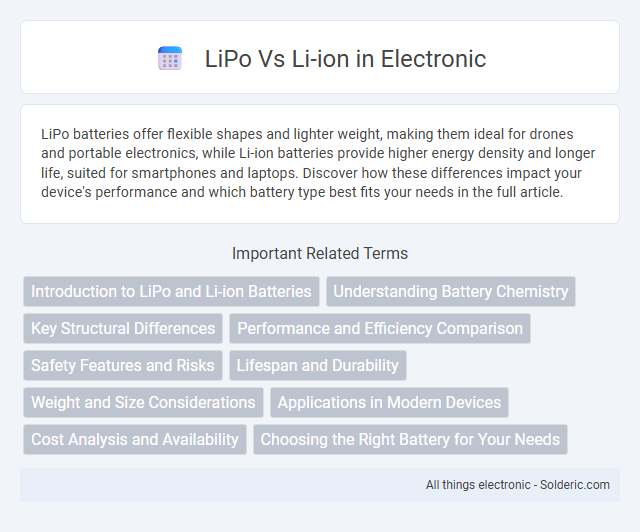LiPo batteries offer flexible shapes and lighter weight, making them ideal for drones and portable electronics, while Li-ion batteries provide higher energy density and longer life, suited for smartphones and laptops. Discover how these differences impact your device's performance and which battery type best fits your needs in the full article.
Comparison Table
| Feature | LiPo (Lithium Polymer) | Li-ion (Lithium Ion) |
|---|---|---|
| Energy Density | Lower (150-200 Wh/kg) | Higher (200-250 Wh/kg) |
| Weight | Lighter | Heavier |
| Shape Flexibility | Flexible, can be molded | Rigid, cylindrical or prismatic |
| Safety | Generally safer, less prone to leaks | More risk of leakage and thermal runaway |
| Cycle Life | Shorter (300-500 cycles) | Longer (500-1000 cycles) |
| Cost | Higher manufacturing cost | Lower cost |
| Common Use | Drones, RC models, smartphones | Laptops, smartphones, electric vehicles |
| Charging Rate | Supports higher charge rates | Moderate charge rates |
Introduction to LiPo and Li-ion Batteries
LiPo (Lithium Polymer) and Li-ion (Lithium-ion) batteries are essential power sources in modern electronics, each offering distinct characteristics. LiPo batteries utilize a polymer electrolyte, allowing for flexible shapes and lightweight designs, while Li-ion batteries rely on a liquid electrolyte, providing higher energy density and longer cycle life. Understanding the differences in chemistry and structure between LiPo and Li-ion batteries helps optimize Your choice for applications like smartphones, drones, or electric vehicles.
Understanding Battery Chemistry
LiPo (Lithium Polymer) batteries use a gel-like polymer electrolyte, enabling flexible, lightweight designs ideal for drones and RC models, while Li-ion (Lithium-ion) batteries employ a liquid electrolyte with higher energy density, commonly found in smartphones and laptops. LiPo chemistry offers safer operation with reduced risk of leakage and better thermal stability, whereas Li-ion batteries provide longer cycle life and generally higher voltage output per cell. Understanding these differences helps optimize battery choice based on application needs such as energy density, weight, safety, and lifespan.
Key Structural Differences
LiPo batteries use a flexible polymer electrolyte, enabling lightweight, thin, and moldable packaging compared to the rigid metal casing of Li-ion batteries that contain a liquid electrolyte. The pouch-like structure of LiPo cells allows for varied shapes and sizes, enhancing design versatility in portable electronics. Your choice between LiPo and Li-ion depends on whether flexibility or energy density and durability are more critical for the application.
Performance and Efficiency Comparison
Lithium Polymer (LiPo) batteries offer higher energy density and faster discharge rates, making them ideal for applications requiring rapid power delivery and lightweight design, such as drones and RC vehicles. Lithium-Ion (Li-ion) batteries provide greater overall lifespan and better thermal stability, resulting in improved efficiency for long-term energy storage in smartphones, laptops, and electric vehicles. The performance efficiency of LiPo excels in high-drain scenarios, while Li-ion batteries are optimized for steady, sustained power output and longer charging cycles.
Safety Features and Risks
LiPo batteries offer enhanced safety with flexible, gel-like electrolytes that reduce leakage and fire risks compared to traditional Li-ion cells using liquid electrolytes prone to thermal runaway. Li-ion batteries typically include built-in protective circuits to prevent overcharging, over-discharging, and short-circuiting, but their rigid structure and volatile electrolytes increase susceptibility to swelling and combustion under abuse. Both chemistries require careful handling and quality control, yet LiPo cells are favored in applications demanding lightweight design and impact resistance with improved safety margins.
Lifespan and Durability
LiPo batteries generally offer a shorter lifespan with around 300-500 charge cycles compared to Li-ion batteries, which typically last 500-1000 cycles due to their more robust electrode materials. Li-ion cells exhibit superior durability under higher temperatures and mechanical stress, making them more reliable for long-term use in devices like laptops and electric vehicles. LiPo batteries, while lighter and more flexible in shape, are more susceptible to swelling and damage from overcharging, impacting their overall durability.
Weight and Size Considerations
LiPo batteries are generally lighter and more compact compared to Li-ion batteries, making them ideal for applications where weight and size are critical, such as drones and portable electronics. Their flexible, pouch-like design allows for customized shapes that better fit limited space, unlike the rigid cylindrical or prismatic cells of Li-ion batteries. Choosing a LiPo battery can optimize Your device's performance by reducing overall weight without sacrificing energy density.
Applications in Modern Devices
LiPo batteries excel in flexible, lightweight designs for smartphones, drones, and wearable devices due to their thin form factor and high discharge rates. Li-ion batteries are preferred in laptops, electric vehicles, and power tools for their higher energy density and longer cycle life. Both technologies enable efficient power management in modern devices, balancing performance with size and weight constraints.
Cost Analysis and Availability
LiPo batteries typically cost more than Li-ion due to their flexible design and lightweight properties, impacting your budget for high-performance applications. Li-ion batteries are more widely available and mass-produced, resulting in lower prices and easier access across various markets. Choosing between LiPo and Li-ion depends on balancing your project's cost constraints with performance and availability needs.
Choosing the Right Battery for Your Needs
LiPo batteries offer lightweight design and flexible shapes, making them ideal for drones and RC vehicles requiring high discharge rates and compact form factors. Li-ion batteries provide higher energy density and longer cycle life, suitable for smartphones, laptops, and devices demanding extended runtime. Understanding your device's power requirements and usage patterns helps you choose the right battery that balances capacity, weight, and durability effectively.
LiPo vs Li-ion Infographic

 solderic.com
solderic.com